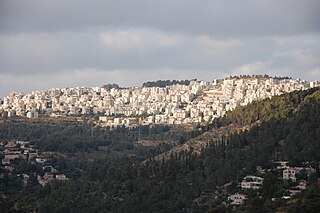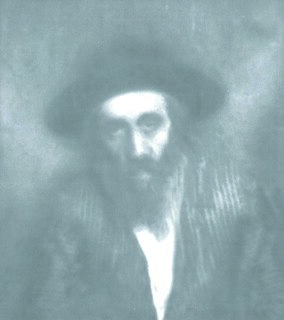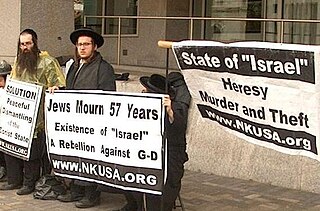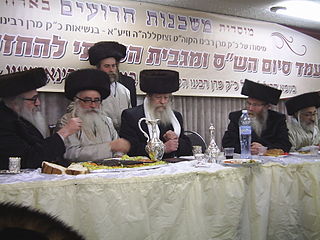
Haredi Judaism consists of groups within Orthodox Judaism characterized by a strict adherence to Halacha and traditions, as opposed to modern values and practices. Its members are often referred to as strictly Orthodox or ultra-Orthodox in English; however, the term "ultra-Orthodox" is considered pejorative by many of its adherents. Haredi Jews regard themselves as the most religiously authentic group of Jews, although this claim is contested by other streams.

Neturei Karta is a religious group of Haredi Jews, formally created in Jerusalem, British Mandate of Palestine, in 1938, splitting off from Agudas Yisrael. Neturei Karta opposes Zionism and calls for a "peaceful dismantling" of the State of Israel, in the belief that Jews are forbidden to have their own state until the coming of the Jewish Messiah and that the state of Israel is a rebellion against god. While the Neturei Karta describe themselves as true traditional Jews, the more secular US-based Jewish Anti-Defamation League has described them as "the farthest fringes of Judaism".

Beit Shemesh is a city located approximately 30 kilometres (19 mi) west of Jerusalem in Israel's Jerusalem District, with a population of 118,676 in 2018. The history of Beit Shemesh goes back to pre-biblical times. The modern city of Beit Shemesh was founded in 1950.

Neve Yaakov also Neve Ya'aqov,, is an Israeli settlement and neighborhood located in East Jerusalem, north of Pisgat Ze'ev and south of al-Ram. Established in 1924 during the period of the British Mandate, it was depopulated during the 1948 Arab–Israeli War. The area was captured by Israel in the Six-Day War and a new neighborhood was built nearby, at which time international opposition to its legitimacy began. The international community considers Israeli settlements in East Jerusalem illegal under international law, but the Israeli government disputes this, defining it as a neighborhood within the jurisdiction of the Jerusalem Municipality, which provides all services. The population of Neve Yaakov is 23,300. Neve Yaakov is one of Jerusalem's Ring Neighborhoods.

Har Nof is a neighborhood on a hillside on the western boundary of Jerusalem, Israel, with a population of 20,000 residents, primarily Orthodox Jews.
Dushinsky is one of the few Hasidic dynasties not named after the place where it originated; instead, it is named after the surname of the Rebbe. It is a relatively new dynasty, as are many of the dynasties originating in Hungary. However, the Dushinsky dynasty truly became a dynasty in Jerusalem, where it is centered today. It is not like other Hasidic groups in that it does not originate from a Hasidic background, but from the talmidim (students) of the Chasam Sofer.

Toldos Aharon is an anti-Zionist Hasidic movement. The group is characterized by extreme conservatism and a desire to preserve the life of the old Yishuv in Jerusalem, in sharp opposition to Zionism, in a strict Haredi way of life, in a special style of clothing, and in an emphasis on prayer at a moderate pace and with enthusiasm. Headquartered in Jerusalem's Meah Shearim neighborhood, it also has significant numbers in Ramat Beit Shemesh, London, and New York City, and additional members in Tiberias and in Harish. The sect has about 1,800 households. Toldos Aharon is a split-off from Shomer Emunim. It is led by its Rebbe, Dovid Kohn.

The Orthodox Council of Jerusalem (OCJ) is a large ultra-Orthodox Jewish communal organization based in Jerusalem, with several thousands affiliated households. It is led by an independent rabbinical court, chaired by the Gaon Convenor, acronymed Ga'avad, and operated by the Rabbi Convenor, Ra'avad. The OCJ provides facilities such as dietary laws supervision, ritual baths, a Sabbath enclosure, and welfare services. The Council was founded in 1921 by devout Ashkenazi residents of Jerusalem, especially of the Old Yishuv, who refused to be affiliated in any way with the new Zionist institutions.
A Moetzes Gedolei HaTorah is the supreme rabbinical policy-making council of the Agudat Yisrael and Degel HaTorah movements. Rabbis sitting on the various Moetzos are usually either one of the more prestigious Roshei Yeshiva or Hasidic rebbes who are also usually regarded by many Haredi Jews to be the Gedolim ("great/est") sages of Torah Judaism. Before the Holocaust, it was the supreme authority for the World Agudath Israel in Europe.

From the founding of political Zionism in the 1890s, Haredi leaders voiced objections to its secular orientation, and before the establishment of the State of Israel, the vast majority of Haredi Jews were opposed to Zionism. This was chiefly due to the concern that secular nationalism would replace the Jewish faith and the observance of religion, and the view that it was forbidden for the Jews to re-constitute Jewish rule in the Land of Israel before the arrival of the Messiah. Those rabbis who did support Jewish settlement in Palestine in the late 19th century had no intention to conquer Palestine and declare its independence from the rule of the Ottoman Turks, and some preferred that only observant Jews be allowed to settle there.
Hardal usually refers to the portion of the Religious Zionist Jewish community in Israel which inclines significantly toward Haredi ideology.
Siget or Ujhel-Siget or Sighet Hasidism, or Sigter Hasidim, is a movement of Hungarian Haredi Jews who adhere to Hasidism, and who are referred to as Sigeter Hasidim.

Mishkenos HoRoim, also spelled Mishkenot HaRoim, Mishkenois HaRoyim, is a small Hasidic group located in Meah Shearim, Jerusalem. It is known as a very isolated and fervently conservative group, known for its virulent anti-Zionism, even by Haredi standards. Mishkenos HoRoim is also known as Kahal Yereim. The main synagogue is located on Meah Shearim Street. There is also a Mishkenos HoRoim synagogue in Ramat Beit Shemesh Bet.

Beit Yisrael is a predominantly Haredi neighborhood in central Jerusalem. It is located just north of Mea Shearim.
The Sikrikim or Sikarikim or Sicarii is a radical group of ultra-Orthodox Jews based mainly in the Israeli ultra-Orthodox neighborhoods Meah Shearim in Jerusalem and in Ramat Beit Shemesh. The anti-Zionist group is thought to have roughly 100 activist members. The Sikrikim gained international attention for acts of violence they committed against Orthodox Jewish institutions and individuals who would not comply with their demands. The name "Sikrikim" comes from "sicarii", a group of Jewish Zealots who attacked Romans and their Jewish sympathizers during the Roman occupation of Judea using concealed daggers, sicae in Latin.
Religious relations in Israel are relations between Haredim, non-Haredi Orthodox, Karaite, Ethiopian, Reform, Conservative, and secular Jews, as well as relations between different religions represented in Israel. The religious status quo, agreed to by David Ben-Gurion with the Orthodox parties at the time of Israel's declaration of independence in 1948, is an agreement on the role that Judaism would play in Israel's government and the judicial system. Tensions exist between religious and secular groups in Israel.

Ganei HaEla is a community of Beit Shemesh in Israel with 96 homes geared toward Dati Leumi Torani and Modern Orthodox Jews.
Yosef Tzvi Dushinsky is the third Rebbe of the Dushinsky Hasidic dynasty of Jerusalem, Israel. He assumed the leadership of the Hasidut upon the death of his father, Rabbi Yisroel Moshe Dushinsky, second Dushinsky Rebbe, in 2003. The Dushinsky Hasidic movement was founded by his grandfather and namesake, Rabbi Yosef Tzvi Dushinsky, in Jerusalem in the 1930s. Both his father and grandfather also served as Gaavad of the Edah HaChareidis.

Knesset Yisrael, also known as Knesset, is the name of a group of three former courtyard neighborhoods in central Jerusalem. Known as Knesset Aleph, Knesset Bet, and Knesset Gimmel, the housing project was planned by the Vaad HaKlali Knesset Yisrael and funded by overseas Jewish donors. The houses were completed in stages from 1892 to 1926. Beneficiaries of the housing were poor Haredi Ashkenazi families and Torah scholars connected to the Central Committee kolel system. Today Knesset Yisrael is part of the Nachlaot neighborhood.
Yaakov Mutzafi was a Mizrahi Haredi rabbi and kabbalist. The last spiritual leader of the ancient Jewish community of Iraq, he moved to Israel ahead of the Jewish masses when they were finally airlifted there in 1952.












